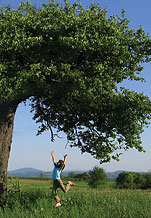Work in Progress
The TreeRadar system emerged as a result of 5 years dedicated research and development. The current system provides the user with an excellent non-invasive technique to detect and evaluate internal decay in tree stems and, perhaps even more importantly, identify and locate tree roots. The importance and complexity of this development should not be underestimated.
Consistent with the ongoing commitment to continually improve the system, the TreeWin™ off-line Analysis Software package is under constant scrutiny to add more customer-led features. As is often the case modification of the software is a relatively quick process. What takes the time is carrying out enough field work to ensure that such modifications produce accurate, reliable and repeatable data.the
The following work is currently underway on the stem and root TreeWin™ analysis software:
Stems
Improved Incipient Decay Detection with better definition of the Solid Wood/Compromised Wood boundary An algorithm has been created that improves the detection of the boundary between incipient (early-stage) decay and solid wood, even in the absence of a hollow (total decay). According to literature sources, up to 80% of wood strength can be lost when incipient decay exists. Comparison of felled trees and tree coring samples to predicted internal conditions have shown good agreement between predicted and actual conditions. |
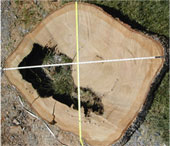 |
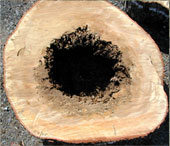 |
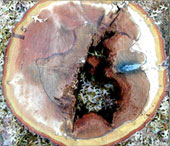 |
Hollow |
Hollow + Visible expanding outer ring incipient outer decay |
Hollow + less evident incipient outer ring (black border) |
Roots
Color Palette showing Root Depth Range on the Top-Down 3D Image A number of TRU users have requested a means for showing the depth of detected roots in the top-down image. A color palette showing the depth in discrete depth ranges will shortly be an added feature. |
Creating Root Morphology Maps The top-down (plan view) 3D root layout and density maps have been shown as a collection of dots indicating the location and depth (coordinates) of each detected root. Many of our customers have requested that the dots be connected so that it is easier to visualize the root structure. An algorithm has been developed that connects-the-dots automatically so that the top-down map truly looks like a root morphology map. This “virtual excavation” is now operational.
|
Estimating Root Diameter Size Some of the factors that distinguish roots from other regular subsurface reflectors such as pipes include: change in direction as they increase in distance from the stem, merge with other roots, split into two or more branches, intertwine with branches from other roots of the same tree or roots close-by trees, etc. Additionally, the issue of distinguishing clusters of small diameter roots from a single large root is involved.
|
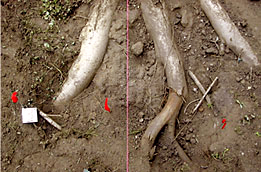 Root diameter estimation is a difficult problem and the university research effort, along with data provided to TreeRadar from its TRU system owners using air spades to excavate portions of scanned surfaces, will help to identify these factors that create complex reflected signals and, ultimately, lead to algorithms that can cope with these signal factors.
Root diameter estimation is a difficult problem and the university research effort, along with data provided to TreeRadar from its TRU system owners using air spades to excavate portions of scanned surfaces, will help to identify these factors that create complex reflected signals and, ultimately, lead to algorithms that can cope with these signal factors.
